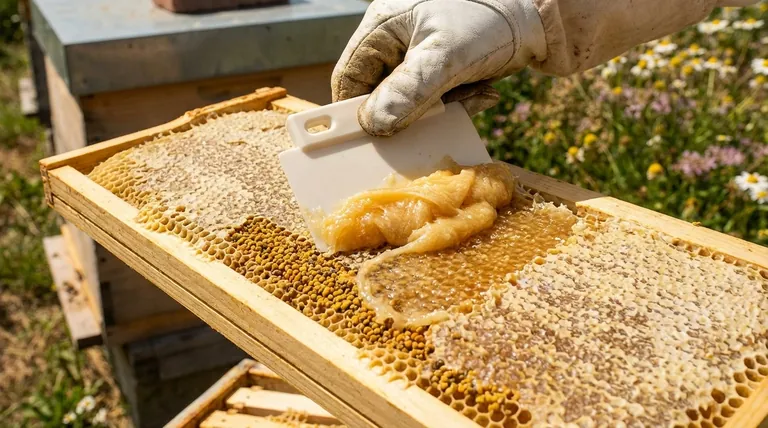At its core, pollen is the unintentional but essential fingerprint of honey. While not a primary ingredient added by bees, its inevitable presence is what confirms a honey's floral origin, contributes to its unique character, and critically influences its texture over time through the process of crystallization.
The presence of pollen is the most reliable indicator of a honey's authenticity and natural state. It acts as both a map to the honey's origin and a catalyst for the smooth, creamy crystallization prized by connoisseurs.

The Accidental Ingredient
Though bees seek nectar to make honey, their fuzzy bodies are perfect vehicles for pollen. This accidental collection and distribution is fundamental to understanding honey's composition.
A Byproduct of Foraging
As a bee moves from flower to flower collecting nectar, it becomes covered in pollen granules. This is a crucial part of plant pollination, but it also means the bee carries this pollen back to the hive.
Transfer Within the Hive
Inside the hive, as bees move about, deposit nectar, and tend to the honeycomb, these microscopic pollen granules are inevitably dislodged and mixed into the stored honey. This makes pollen a natural, albeit minor, component of any raw honey.
The Role of Pollen in Honey's Identity
Far from being a simple contaminant, pollen provides a wealth of information and subtle characteristics that define a specific batch of honey.
A Map to the Flower
The most critical role of pollen is traceability. Experts in a field known as melissopalynology can analyze the specific types of pollen in a honey sample to identify the exact floral sources the bees foraged from. This confirms the honey's geographic and botanical origin.
Subtle Contributions to Character
While the nectar source is the primary driver of a honey's flavor and aroma, the specific pollen blend adds a subtle layer of complexity. It contributes to the unique character that distinguishes a honey from a particular region and season from all others.
The Physical Impact: Pollen and Crystallization
Pollen plays a direct, physical role in one of honey's most misunderstood properties: crystallization. This process is natural and often desirable.
The Nucleation Point
Honey is a supersaturated sugar solution. Over time, the glucose will begin to separate from the water and form crystals. Pollen granules, along with tiny wax particles, act as nucleation points—surfaces that the sugar crystals can begin to form on.
The Path to Creamed Honey
The presence of many tiny nucleation points, like pollen, encourages the formation of a large number of very small, fine crystals. This leads to a smooth, thick, and spreadable texture often described as "creamed" or "spun," a quality highly valued by many honey lovers. Without these particles, crystallization can be slower and result in larger, grittier crystals.
Understanding the Trade-offs: The Impact of Filtering
The commercial desire for honey that remains liquid and clear has led to processing methods that directly conflict with pollen's natural role.
Why Honey is Filtered
Many large-scale honey producers use ultra-fine filters to remove all suspended particles, including pollen. The primary goals are to prevent or significantly slow down crystallization, increase shelf life, and create a visually uniform, clear liquid that some consumers prefer.
The Cost of Purity
While filtering achieves a consistent appearance, it removes the very elements that prove the honey's authenticity. A honey without pollen loses its geographical fingerprint and the subtle characteristics that make it unique. It also loses the catalyst for the desirable, fine-grained crystallization process.
Making the Right Choice for Your Goal
Your preference for honey should dictate whether you seek out pollen's presence or absence.
- If your primary focus is authenticity and traceability: Choose raw and unfiltered honey to ensure the pollen—and thus the proof of origin—is still present.
- If your primary focus is a unique, artisanal character: Opt for unfiltered honey and embrace crystallization as a sign of its natural quality and the key to a creamy texture.
- If your primary focus is long-term liquidity and clarity: A filtered honey will meet your needs, but acknowledge that this comes at the cost of the honey's natural identity.
Understanding the role of pollen empowers you to choose honey based on its true character, not just its appearance.
Summary Table:
| Role of Pollen | Impact on Honey |
|---|---|
| Traceability | Confirms floral and geographic origin (melissopalynology). |
| Character | Adds subtle complexity to flavor and aroma. |
| Crystallization | Acts as a nucleation point for fine, creamy crystals. |
| Authenticity | Proves honey is raw and unfiltered. |
Elevate Your Beekeeping Operations with Premium Supplies
As a commercial apiary or distributor, you understand that the quality of honey starts with the health of your bees and the equipment you use. HONESTBEE supplies durable, high-performance beekeeping supplies and equipment designed to support the natural processes that create superior honey. From hive tools that protect your colonies to extraction systems that preserve honey's integrity, our wholesale-focused solutions help you maximize yield and maintain authenticity.
Ready to enhance your honey's quality and your operational efficiency? Contact our expert team today to discuss your specific needs and discover how HONESTBEE can be your trusted partner in beekeeping success.
Visual Guide

Related Products
- Professional Wide Blade Honey Scraper for Beekeeping and Honey Processing
- Professional Galvanized Hive Strap with Secure Locking Buckle for Beekeeping
- Professional Long-Handled Silicone Honey Scraper for Beekeeping
- Stainless Steel Honey Press Wax Press with Tank
- Retractable Chinese Queen Rearing Grafting Tools Equipment
People Also Ask
- What equipment do you need to make honey? A Complete Guide to Starting Your Apiary
- What tools are available for uncapping honey? A Guide to Choosing the Right Tool for Your Operation
- How do you encourage bees to cap honey? Optimize Hive Conditions for a Perfect Harvest
- Can I extract uncapped honey? Avoid spoilage by trusting the bees' quality control.
- Why is my honey frame not capped? Your Guide to Perfectly Ripe Honey



















